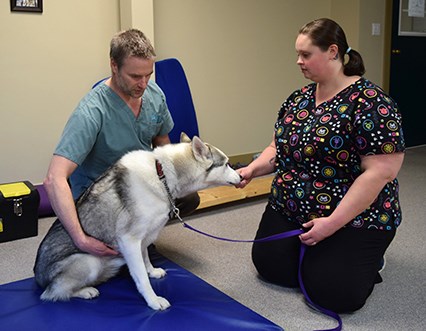For the uninitiated, it would appear Siberian husky Maquita is getting some ticks taken out of her back as veterinarian David Lane dips his hand in and out of the dog’s grey and white fur. On closer inspection, it’s clear Lane is actually placing acupuncture needles into the dog’s back. Maquita doesn’t seem to mind. She is being distracted by treats doled out by her owner, Montana Dullemond, and Lane seems to have a calming effect on the canine.
Lane, who works out of Squamish’s Eagleview Veterinary Hospital, is a rare find. He recently became accredited as one of only about five canine veterinary sports medicine and rehabilitation (VSMR) specialists in Canada. Currently, there are approximately 100 such specialists in the world, according to Lane. It’s a branch of veterinary medicine that addresses muscular, joint and spinal cord disorders. “Anything that effects how a dog moves – anything causing discomfort, weakness or altered mobility,” said Lane as he removed the acupuncture needles. He then began to massage Maquita’s hindquarter.
While the specialty came out of treatments for working and competition dogs, the techniques work for all dogs.
Lane said at this point, one-third of his practice is comprised of working and competition dogs, one-third is second opinion lameness consultation and one-third is palliative or geriatric care – “these old arthritic dogs, keeping them comfortable and mobile.”
Competition dogs are no more prone to needing treatments, Lane said, but owners have a higher level of awareness of their dogs’ health. “It wasn’t really until the popularity of agility [competitions] took off where… the owners have become very exacting in their expectations and they notice stuff that the regular pet owner doesn’t,” he said. “If they are a half-second off their normal time, they’re coming in.”
The increased expectations of competitive dog owners put pressure on vets to pick up their game, according to Lane and that led to the specialty, which fully emerged about five years ago.
Squamish is a great place to centre such a practice because dogs here, like their owners, are active.
“A part of how I fell into this is just living in this corridor,” Lane said. “People want these dogs to return to a high level of athleticism.”
Lane has treated Darlene Higgs’ canine family members, she said, “addressing their needs at different stages of life – active early years as well as geriatric stages and even end of life care for two of them.”
“It is the integrated rehab therapy and help we have received when our pets have experienced restricted or painful movement that truly has been amazing, through his use of acupuncture and chiropractic medicine.”
Edith Tobe has taken a few of her active dogs to Lane over the years. Tobe’s aging Australian cattle dog Angel, who had ligament surgery by Lane in 2010, received chiropractic adjustments, acupuncture and massage treatments from Lane monthly before the dog died at the age of 16.
The difference between Angel’s mobility before and after the treatments was huge, Tobe said. “The results of his treatment are instant,” she said.
If her dogs can’t remain active enough to get out on trails, that would be a deal-breaker for her, she said.
The treatments aren’t cheap, Tobe acknowledged, particularly since she doesn’t have insurance, but she considers it worth it for her dogs’ well-being. “For me it was part of what I earn a living for,” she said.
The treatments cost roughly $230 for an initial consult and about $100 for follow-up appointments.
To become a VSMR specialist, Lane had to demonstrate he had practical experience treating lameness conditions in dogs, take an exam and provide evidence of having completed published research. Lane’s research looked at the effectiveness of combining acupuncture with manual therapy to reduce pain. Manual therapy includes techniques used most commonly by human chiropractors and physiotherapists. Lane said his research found two treatments were enough to reduce stiffness and improve the dogs’ mobility.
However, with so few vets doing the treatments, there aren’t enough instructors teaching the techniques in veterinarian school. “So the people aren’t graduating from vet school being exposed to it and then they get exposed to it afterwards and they don’t have the background or the comfort knowledge,” he said. “There is a lot that we need to do from an educational point of view to get information out there about what the options are.”



